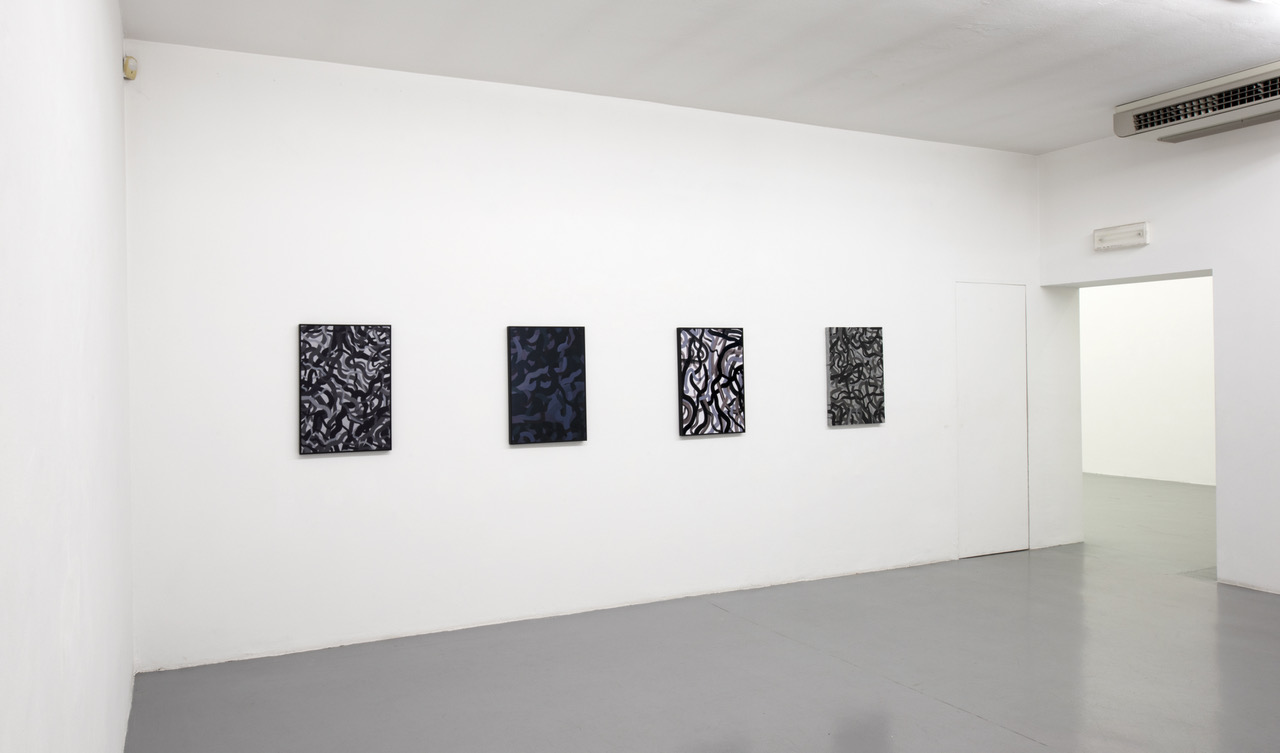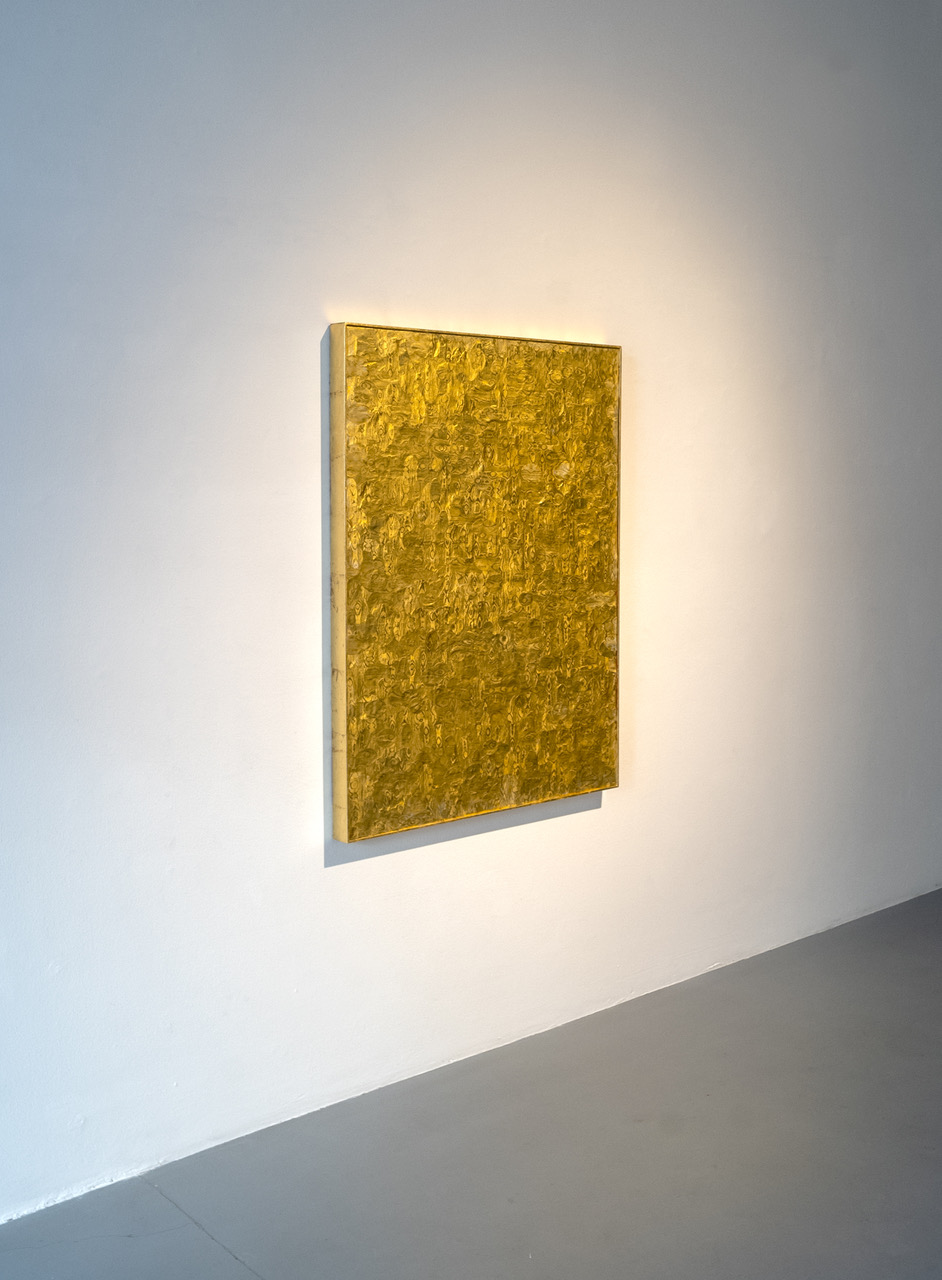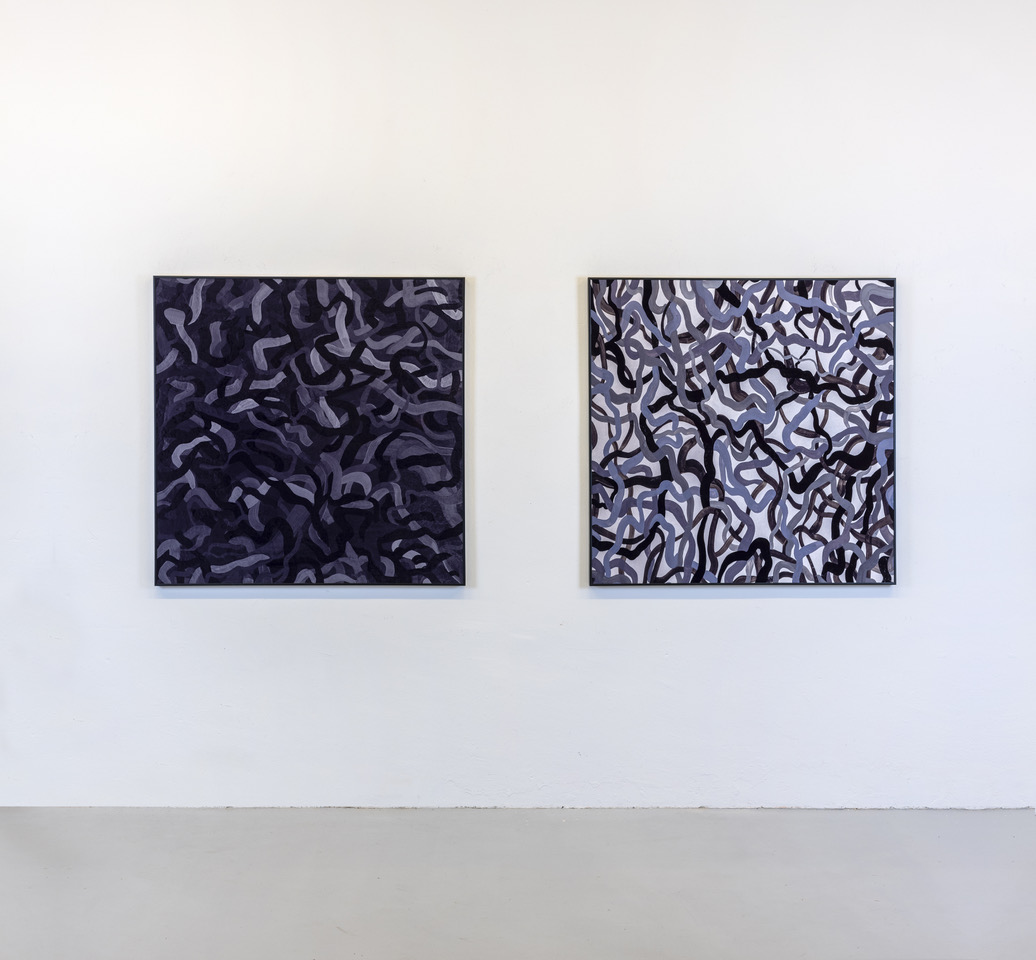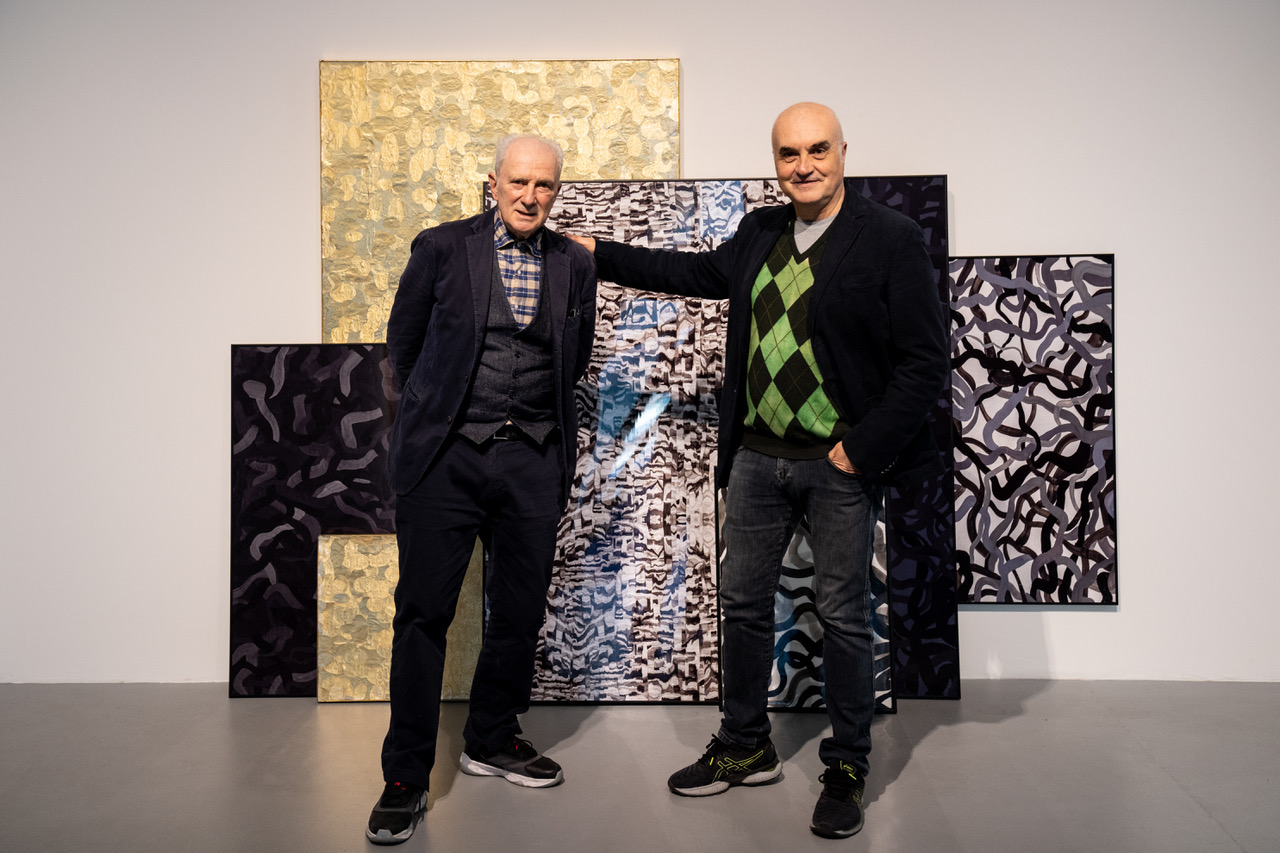15.01 – 26.02.2022 Galleria Massimo Minini, Brescia
15.01 – 26.02.2022 Galleria Massimo Minini, Brescia
A volte basta spostare un accento…
Immaginate che il titolo di un racconto o di un comunicato stampa o di una favola sia “immaginàle”.
E che quello di un’altra favola sia “immàginale”.
Il primo afferisce direttamente all’immàgine, potremmo dire: “che suscita immagini” oppure “denso di immagini”.
Certo, una parola sola, neppure tanto usuale, anzi oltremodo inconsueta, messa lì in mezzo alla pagina bianca, fa presupporre che l’estensore (come qui lo scrittore di questo breve elzeviro) voglia fare sfoggio della propria erudizione e anche della propria dimestichezza con le difficoltà della scrittura (e naturalmente della lettura).
Sì, perché uno non ti sbatte in faccia una parola come questa, più o meno come le parole delle eccezioni in latino o gli apax legòmenoi del greco, parole pochissimo usate (o addirittura usate una sola volta in tutta la storia della letteratura).
Alle medie, quando studiavamo il latino, passavamo ore ed ore su questioni che non avremmo più ri-incontrato nella nostra carriera di svogliati studenti.
Un po’ come accadeva con il francese o l’inglese di cui ci venivano sottolineate tutte le varianti possibili di verbi che facevano eccezione e che mai più ci sarebbe capitato –fortunatamente- di utilizzare.
E poi al pub naturalmente davanti ad un bitter non sapevamo che dire e come dirlo.
Immàginale invece, con quel suo imperativo senza scampo ci obbliga o ci consiglia caldamente a far funzionare la nostra fantasia creativa e, chiusi gli occhi, a pensare ad una realtà diversa, immaginata. (“Imma” nella cultura sufi significa vedere col cuore).
Immaginazione è nascita continua quindi ri-nascita di immagini.
Un po’ come Ian Wilson spiega il proprio lavoro: aperto e non chiuso ad esperienze sensoriali, che permettono di raggiungere l’illuminazione durante una passeggiata in un bosco, nei campi o in un museo davanti a un dipinto.
Oppure come la radice del lavoro di Robert Barry che ha selezionato un numero molto ristretto di parole che aprono e non chiudono, indicando orizzonti lontani e onnicomprensivi e non lo hic et nunc dell’implacabile evidenza dell’oggetto.
Questa dotta dissertazione riguarda il titolo ma non il contenuto della mostra e delle opere che sono degli pseudo dipinti ottenuti raffreddando gli originali ad olio con l’intervento tecnico della fotografia.
L’autore dipinge grandi superfici con l’oro, con il nero e relativi passaggi di grigio; l’effetto è quello di una decorazione dove la traccia del pennello è un segno a curve continue che tende ad occupare tutta la campitura della tela. L’oro e il nero sono in un certo modo antitetici, luce per uno e buio per l’altro.
Dall’oggi al domani, dalla vita alla morte, dall’alfa all’omega, dallo yin allo yang senza soluzione di continuità.
Massimo Minini, 1 gennaio 2022
All we need to do sometimes is shift the stress…
Imagine that the title of a story, of a press release, of a fairy tale is “immaginàle” (imaginal in English), with the stress on the third syllable.
Imagine now that another narrative is entitled “immàginale” (imagine them in English), with the stress shifting to the second syllable.
The former, immaginàle, relates directly to an image, it could be defined as: “evoking images” or “laden with images”. Surely, a single word, not exactly a common one at that, indeed truly unusual, placed right in the middle of a blank page, suggests that the author (just like the writer of this arts feature) may want to show off their erudition as well as their familiarity with the difficulties of writing (and, of course, of reading).
Actually, it is not on to throw a word like this in your face, more or less like Latin exceptions or the Greek hapax legomena, words very rarely used (or used just once in the whole history of literature).
In secondary school, we used to spend hours on end studying Latin questions that we would never come across again in our listless students’ careers.
A bit like what happened with French or English, with all the potential exceptions of their verb systems that -luckily- we would never use again.
Then, when ordering a drink in the pub, of course we wouldn’t know what to say or how to say it.
In contrast, the imperative of the latter, immàginale, affords no way out, forcing or strongly encouraging us to set our creative imagination in motion, to close our eyes and think of an alternative, imagined reality. (“Imma” in the Sufi culture means seeing through the heart).
Imagination means continuous birth, therefore the rebirth of images.
A bit like Ian Wilson explaining his work: open and not closed to sensory experiences, which allow you to attain enlightenment while walking in the forest, through the fields or in a museum in front of a painting. Or else the root of Robert Barry’s work, a very limited selection of words that open and do not close, pointing to distant and all-encompassing horizons and not to the palpable reality, the relentless evidence of an object.
This learned dissertation concerns the title and not the content of the exhibition or of the works, pseudo-paintings created by cooling the original oil paintings through the technical intermediation of photography.
The artist paints large surfaces with gold, black and various gradations of gray; the effect is a decoration where the brushstroke traces continuous curves that tend to occupy the entire background of the canvas. Gold and black are somewhat antithetical, gold is light, black is darkness.
From one day to the next, from life to death, from alpha to omega, from yin to yang, endlessly.
Massimo Minini, 1 January 2022
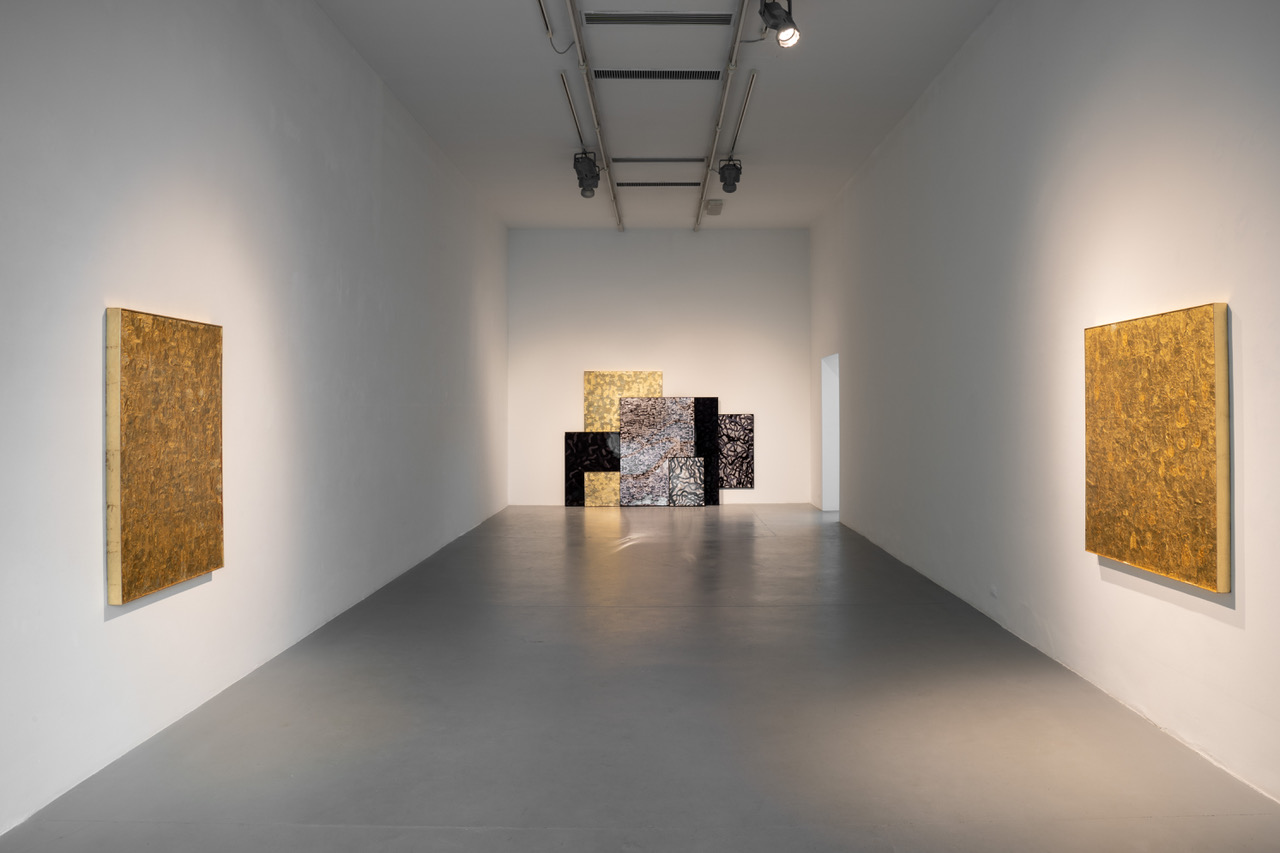
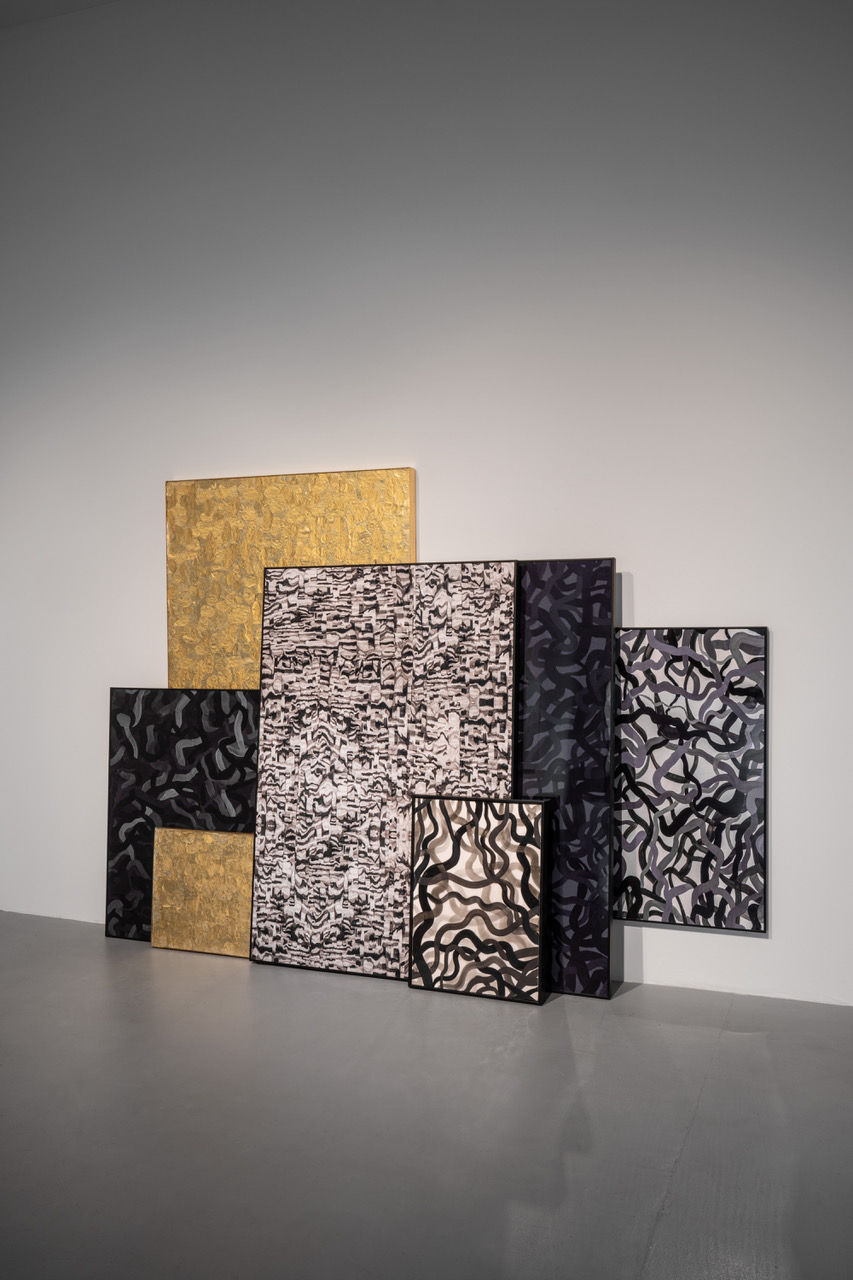
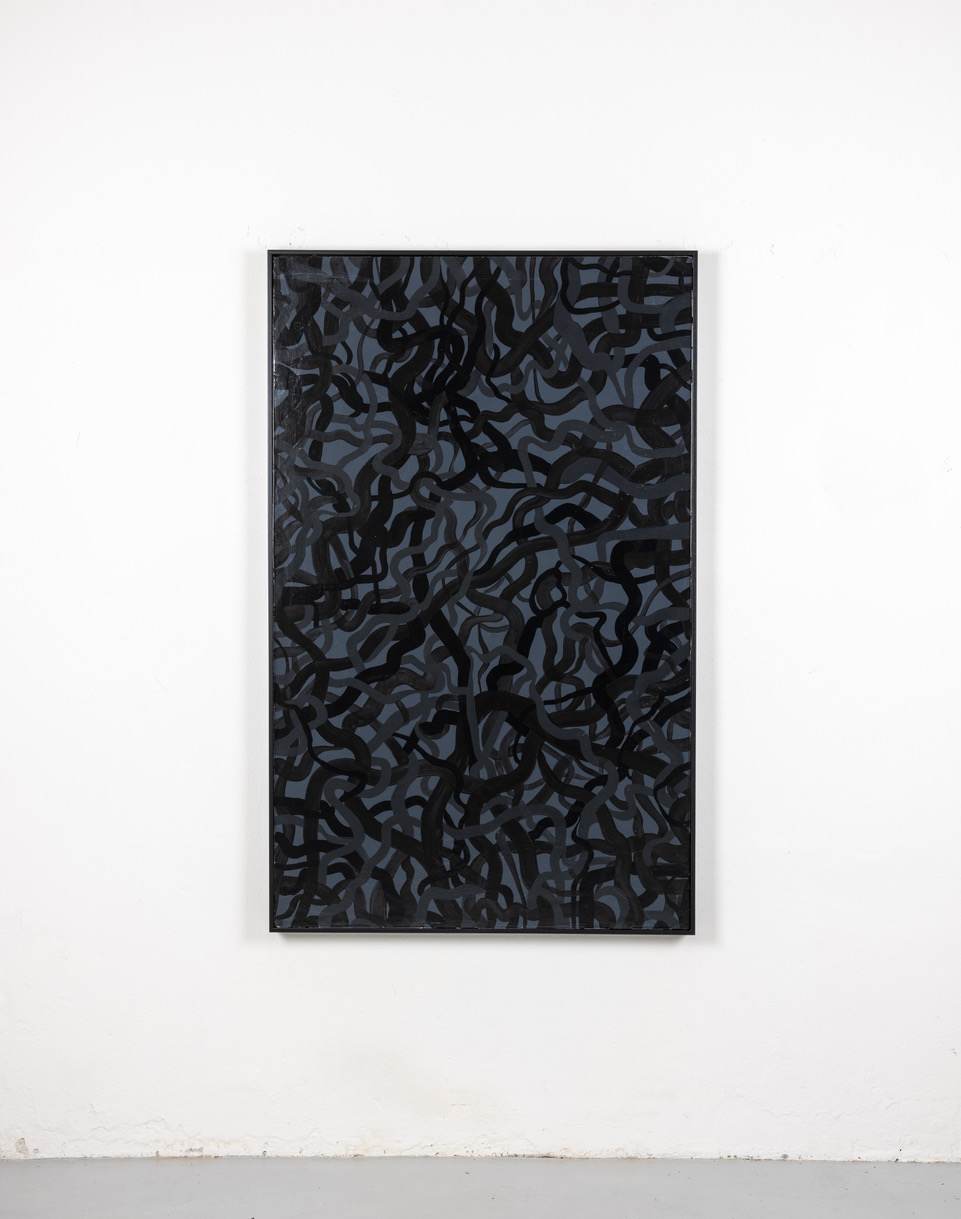
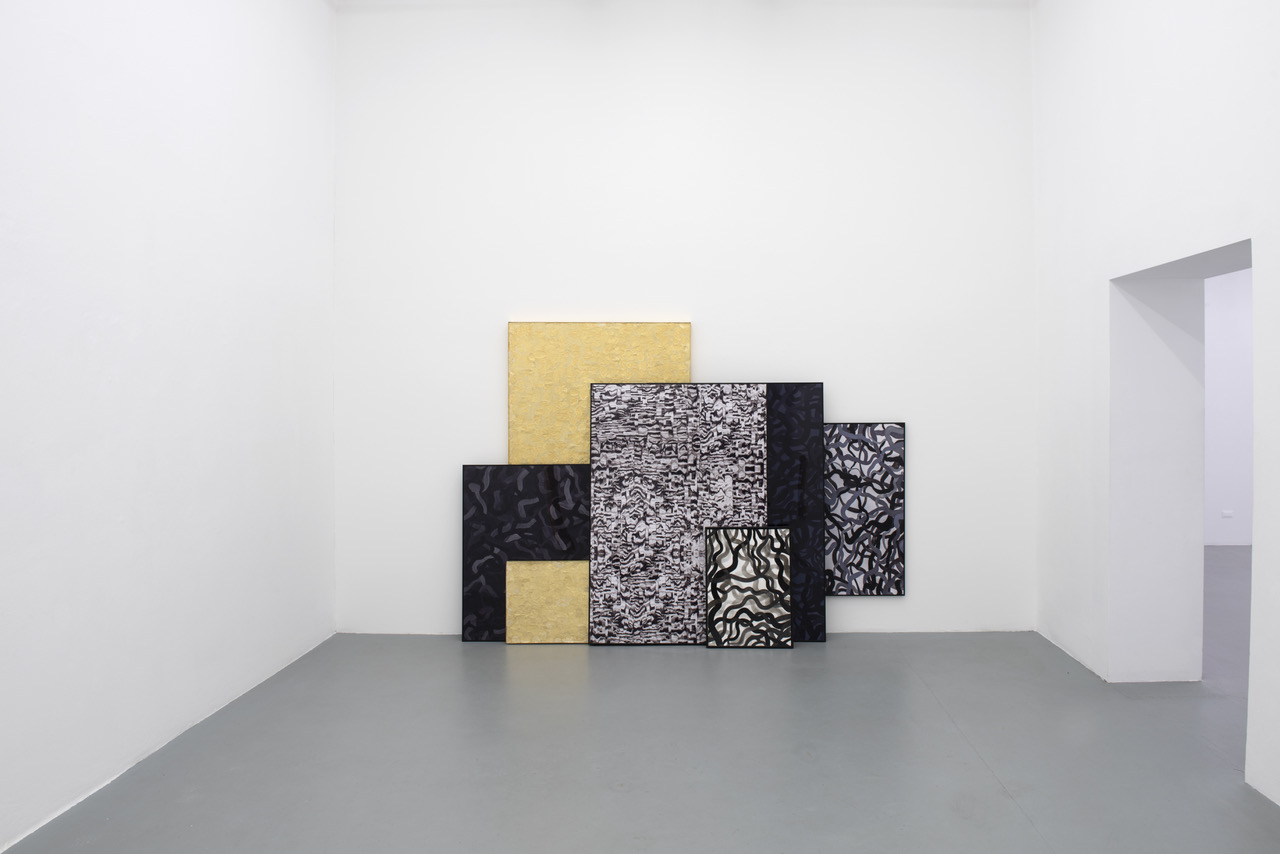
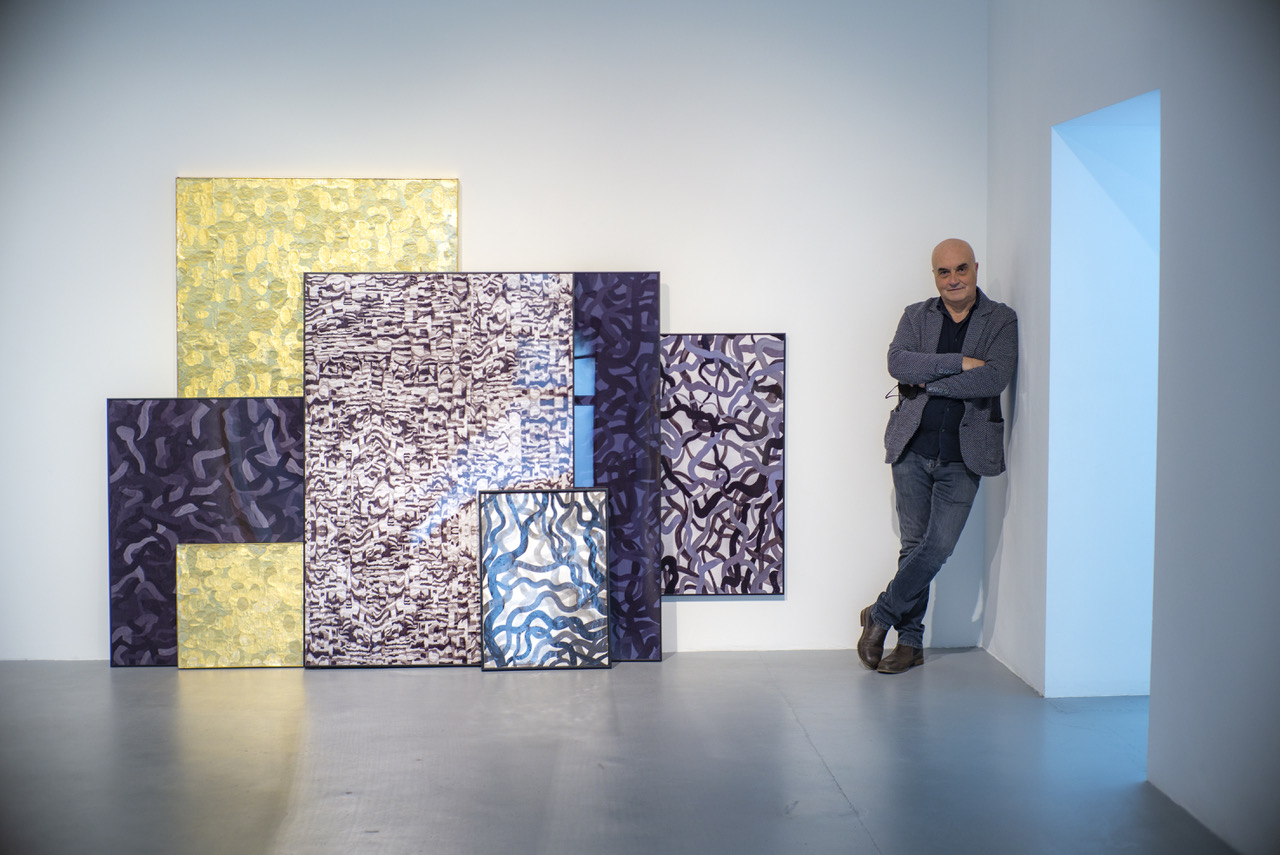
Due parole sull’immaginàle
Esiste un rapporto molto stretto tra l’immaginazione e l’intuizione.
Il filosofo Gaston Bachelard a proposito dell’intuizione ha scritto che essa non si dimostra, si sperimenta.
Io credo che allo stesso modo si potrebbe dire dell’immaginazione, perché ogni discussione attorno e a proposito di tale termine ha efficacia solo se si fa esperienza immaginale, e soprattutto se questa fragile esperienza è condivisa.
La parola immaginazione non deve essere confusa con la parola fantasia che è solo il debole gioco dei nostri pensieri, nella nostra lingua la parola immaginazione spesso assume un significato quasi di degradazione, di fantasticheria (forse) senza scopo, comunque di qualcosa di opposto alle granitiche certezze della realtà.
Henry Corbin nel prologo alla seconda parte del suo libro (L’immaginazione Creatrice) scrive: «Come si può pensare non già che sia il caso di parlare, ma addirittura cominciare a parlare della necessità di andare al di là della realtà nel suo stato dato, e soprattutto di superare la solitudine dell’io lasciato a se stesso in questo mondo imposto (il nient’altro-che-io, Nur-Ich-Sein, la cui ossessione può portare alla follia), se fin dall’inizio non si avverte in fondo a se stessi questo superamento?».
Ancora una volta il richiamo ad una discussione condivisa, dove l’esperienza individuale (dell’immaginante) è fondamentale quanto parallelamente è fondamentale lo-stato-dato della cosiddetta realtà.
E’ basilare comprendere il legame indissolubile che lega il visibile e l’invisibile alla nostra coscienza e il loro apporto all’interpretazione del mondo.
La parola immaginazione, oltre che dal termine latino imago, prende origine anche da una parola sufi “himma” che significa “il potere creatore del cuore”.
Al sostantivo “immaginazione” preferisco il termine più complesso di “immaginale” perché tale termine ci colloca in un territorio intermedio sospeso tra percettibile e impercettibile.
Tutte le nostre immagini oscillano in questa terra-di-mezzo e richiedono alla nostra mente lo sforzo e la possibilità di essere (anche) qualcosa di diverso dalla loro configurazione, ci chiedono di essere (anche) qualche cosa d’altro, proprio per non farci finire imprigionati in quella “solitudine senza scopo” che è la letteralizzazione del mondo.
Di approccio immaginale alla realtà parla molto anche lo psicoanalista James Hillman che definisce l’immaginale “il pensiero del cuore” e “una cura dell’anima”; ma tanti sono gli autori che lo hanno preceduto e seguito in questa direzione (solo per citare un italiano fra i più interessanti: il filosofo Paolo Mottana).
Io credo che ogni forma d’arte sia da sempre, (anche all’insaputa del proprio autore), una sorta di ermeneutica che oltrepassa l’oggetto esteriore attraverso lo sforzo di una sensibilità interiore, impedendo (all’artista in primis) di cadere nella trappola di una realtà schematica riduttivamente razionale e normativa.
Non ci sono risposte, esiste soltanto il percorso e di volta in volta il significato.
Maurizio Donzelli
A few words about the “immaginàle” (imaginal in English)
There is a very close relationship between imagination and intuition.
The philosopher Gaston Bachelard wrote about intuition that it is not demonstrated, it is experienced.
I believe the same could be said of the imagination, because any discussion around and about that term is only effective if there is imaginal experience, and especially if this fragile experience is shared.
The word imagination should not be confused with the word fantasy that is only the weak game of our thoughts, in our language the word imagination often assumes a meaning almost of degradation, of (perhaps) aimless reverie, however of something opposite to the granitic certainties of reality.
Henry Corbin in the prologue to the second part of his book (The Creative Imagination) writes: «How can one think not only that it is appropriate to speak, but even to begin to speak of the need to go beyond reality in its given state, and above all to overcome the loneliness of the ego left to itself in this imposed world (the nothing-but-ego, Nur-Ich-Sein, whose obsession can lead to madness), if from the beginning one does not feel at the bottom of oneself this overcoming?»“.
Once again, the call for a shared discussion, where the individual experience (of the imaginant) is as fundamental as, in parallel, the state of so-called reality.
It is basic to understand the indissoluble link that binds the visible and invisible to our consciousness and their contribution to the interpretation of the world.
The word imagination, besides the Latin word imago, also originates from a Sufi word “himma” which means “the creative power of the heart“.
To the noun “imagination” I prefer the more complex term of “imaginal” (immaginàle in Italian) because this term places us in an intermediate territory suspended between perceptible and imperceptible.
All our images oscillate in this middle-earth and require from our mind the effort and the possibility to be (also) something different from their configuration, they ask us to be (also) something else, just not to let us end up imprisoned in that “solitude without purpose” that is the literalization of the world.
The psychoanalyst James Hillman also talks a lot about the imaginal approach to reality, defining the imaginal as “the thought of the heart” and “a cure for the soul”; but there are many authors who have preceded and followed him in this direction (just to mention one of the most interesting Italians: the philosopher Paolo Mottana).
I believe that every form of art has always been, (even without the author’s knowledge), a sort of hermeneutics that goes beyond the external object through the effort of an inner sensitivity, preventing the artist from falling into the trap of a reductively rational and normative schematic reality.
There are no answers, there is only the path and, from time to time, the meaning.
Maurizio Donzelli
